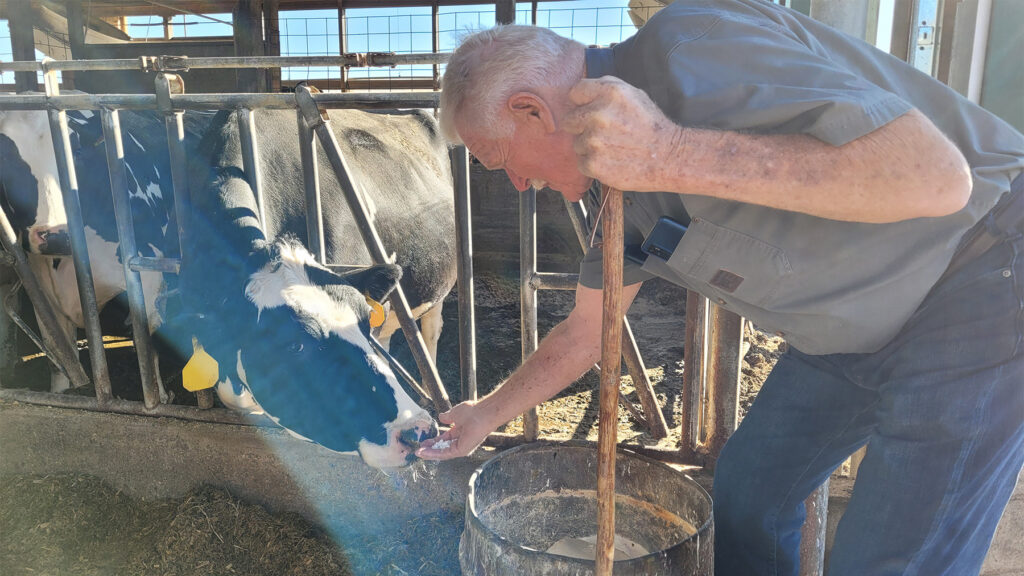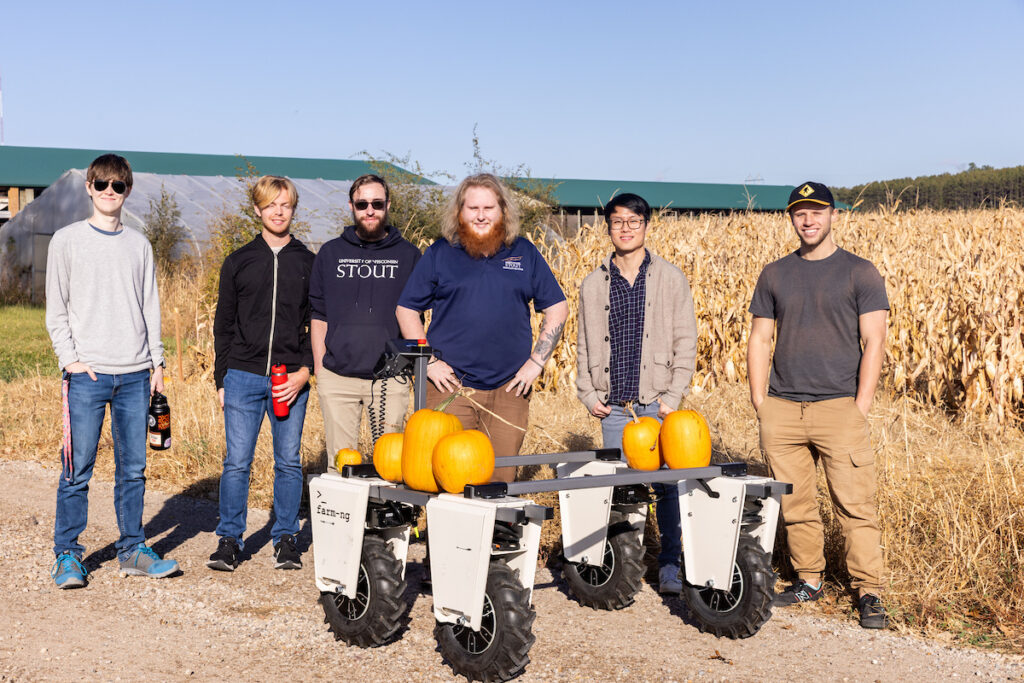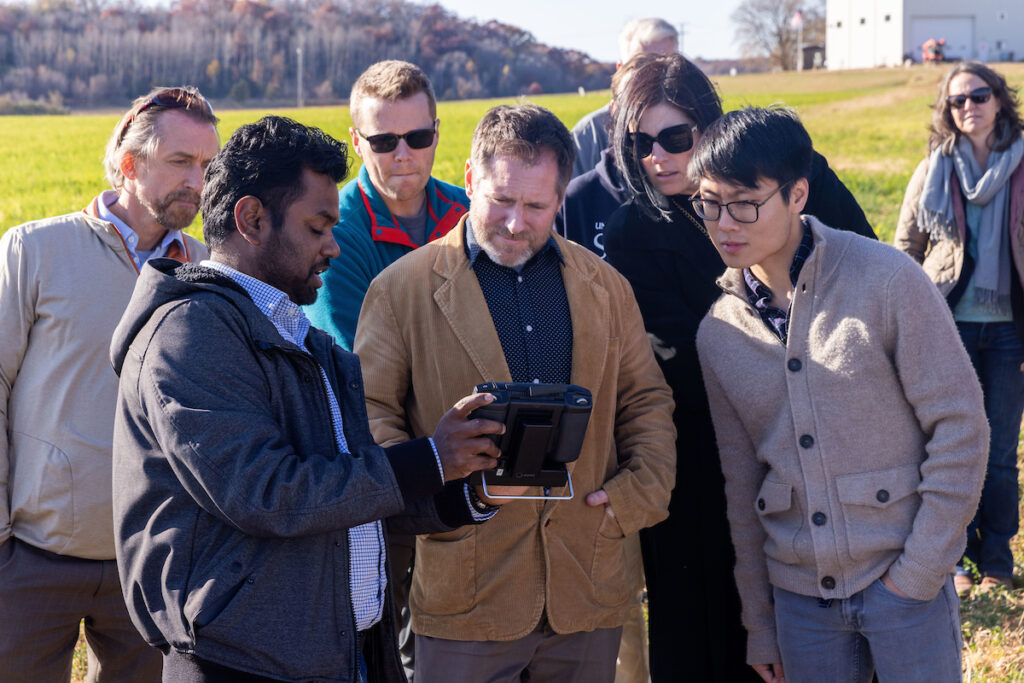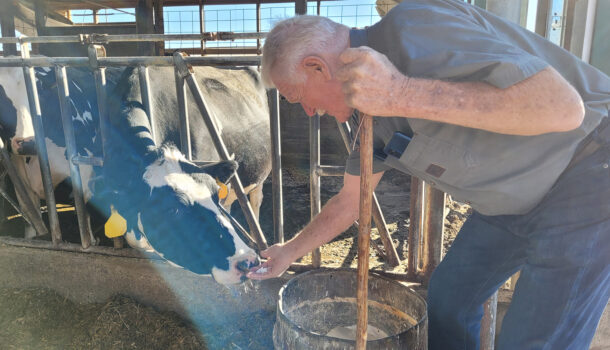Above Photo: The presentation was attended by faculty, staff, students and area farmers.
Engineering and social science professors at University of Wisconsin-Stout are helping to advance the next generation of agricultural support systems to ensure that new technologies meet the needs of Wisconsin farmers.

“This system is the first of its kind available to the farmers in Wisconsin. The uniqueness includes the energy-saving orientated AI algorithms and human-centered DIY hardware design.”
Through customized, energy-efficient, low-cost technology for precision agriculture, the team is looking to improve productivity, enhance farming efficiency, increase crop yield and quality and boost profitability for farmers with beef and grazing cattle, small dairies, specialty and large cash crops and agronomists.
The project, A HumanCentered Collaborative Approach to Designing an Energy-Efficient Wireless Sensor Network, includes several aspects: a ground wireless sensor network, machinery for automation, livestock monitoring and drone data collection to help farmers make informed decisions based on real-time and historical data.
The team, led by UW-Stout engineering Professor Yuan Xing, overseeing the overall system design, and applied social science Program Director Tina Lee, includes UW-Stout engineering professors Cheng Liu, sensor hardware implementation, and Abhishek Verma, UAV (unmanned aerial vehicle) system design, as well as UW-River Falls Professor Bob Zhiwei Zeng, agricultural machinery design.
The cross-disciplinary engineering/social science project received a two-year, $175,000 Universities of Wisconsin Innovation Grant.
The team recently demonstrated the prototypes and machinery at Mann Valley Farm in River Falls.
The demonstration included how AI methodologies for data analysis can be integrated into each system, allowing farmers to view historical data of their property, including weather- and animal-related data and more.
“These technologies are available now, but we want the data results to be useful to farmers at an affordable price,” Xing said. “This system is the first of its kind available to the farmers in Wisconsin. The uniqueness includes the energy-saving orientated AI algorithms and human-centered DIY hardware design.”
Engineering faculty, college deans, area farmers and AI professionals attended the demonstration, as well as student members of UW-Stout’s Artificial Intelligence Club, who are interested in the progression of technology, and how it can change the future of farming and be applied to other areas.
A human-centered approach to technology
The project began this spring, when Lee held eight preliminary interviews with farmers in Dunn, Barron and St. Croix counties to learn how the technology could be designed to meet their individual needs.
“Farmers feel a great pressure to be profitable, while remaining environmentally friendly,” Lee said. “We need to understand their point of view, while making sure the technology is readily available at a low cost, is efficient, easy to use and easy to learn how to use.
“Then, what do we do with all the data collected? We need to understand how to make that data useful, as each type of farmer has different needs based on their crops or livestock, so the system is designed to be customized based on a farmer’s needs,” she added.
Originally, the engineering faculty and Lee were applying separately for the Innovations Grant, but university leadership encouraged them to join forces, Lee said.


Wireless sensor networks: a miniature weather tower
The HOBO energy-efficient wireless sensor network has up to 50 sensors to monitor water management, solar intensity, humidity, rainfall, soil health, and wind speed and direction.
The miniature weather tower has a simple graphical user panel. It is solar-powered and runs on an internal battery, making it 99% energy efficient. It stands about 10 feet tall, with an adjustable height, and is grounded in case of severe weather, Liu said.
The wireless sensor network at Mann Valley Farm has been in place since June, collecting data in a cornfield.
“The sensor network is reasonable and practical because of the high amount of data collected at a low cost,” Liu said. “A farmer can remotely manage their sensor data, and data is accessed via an app on their phone. Historical data can be viewed in the HOBO online data dashboard to assist farmers with farming decisions.”
The AI data analysis system runs algorithms to process data and help a farmer make informed decisions, Xing said.
“The AI model is trained to predict weather conditions based on historical data of the farm, such as moisture in an afternoon based on data collected that morning. New data can be predicated based on historical data, and the more data that is collected allows AI to calculate more accurate predictions within 5% accuracy,” Xing said.
The AI model can also be trained to identify types of pests or diseases present based on photos, but the training takes time, he added.



The ease of automation for specialty crop farmers
The Amiga robot, by Farm-ng, is a battery-operated micro-tractor designed for 24/7 automation in specialty crop farming. The all-terrain, all-weather robot can be used:
- As a scouting robot in the field, programmed for pest and disease control
- For weeding or harvesting of specialty crops, such as lavender or berries
- To capture real-time images at ground level, with a mounted vision sensor camera.
The Amiga can be trained to learn the parameters of a field. It can hold up to 1,000 pounds and travel 5 1/2 mph, fully loaded for four to five hours, or eight hours on light duty. Its ground clearance is about two feet, and its height and width can be adjusted as needed, Zeng said.
Liu installed a $120 mini-PC into the Amiga for data collection.
Livestock monitoring to save time and money
A computer vision system offers a high-resolution live camera and video feed of livestock in a field or barn. The video feed tags individual animals and includes a real-time behavior analysis, such as if an animal is standing, feeding or sleeping. It can also count the number of animals present.
The Cow Manager software has an online dashboard to help a farmer monitor and track an individual animal’s health, such as its digestion or body temperature to predict fertility or stress.
“A farmer can know days before a cow will be in heat if they need to have a bull ready on hand or to know when the cow will be viable for artificial insemination. This can save a farmer time and money,” Zeng said.
The software analysis can also be loaded into an AI model to predict future health conditions based on an animal’s present state.
Collecting drone data from the seat of your tractor
A drone, or UAV monitoring system, can be used to collect data through high-resolution photos and video.
For farming purposes, the UAV can be used to photograph bare ground, dry grass or fresh plants. It can detect pests, weeds, water content or nutrient deficiency through a hyperspectral camera. Farmers can have an aerial view of their entire crop from their front porch.
“For instance, simple image processing of a corn field can be used to estimate its water content by running a low complexity AI model,” Verma said. “The drone can cover 60 acres in two hours, and the data collected can then be analyzed in minutes.”
The UAV can be taught the parameters of a field, similar to geofencing, and can be programmed to follow an optimal flight path over crops. It can correct its path to stay on course if there is a change in wind speed or direction, Verma said.
“Fifty feet is the optimal height for data collection, and the camera offers a maximum zoom of 200X. The map on the handheld control panel shows a real-time location and video feed,” he added.
The team will continue testing and collecting data throughout the fall and will conduct a broader survey and interview five to seven more farmers this winter.
Design modifications will begin in 2025 when the team will gather feedback for improvements from participating farmers. Seminars will be held in select counties across the state to explain the system and offer farmers free trial use of the prototypes, with a finalized system planned for December 2025.
The project is an outgrowth of UW-Stout’s CROPS — the emerging Center for Rural Opportunity, Prosperity and Sustainability. CROPS is piloting ongoing research about issues facing rural communities, including farm consolidation, the loss of population and small businesses, rural poverty and environmental issues related to conventional agriculture.
Professors received initial support from the Dunn County Land and Water Conservation Division; Joe Ailts of Ailts Agronomy, a crop consultant serving farmers in northwest Wisconsin; and a local farmer.
In 2022, UW-Stout mathematics professors received a $36,000 grant from the Freshwater Collaborative of Wisconsin for a similar project, Crop Per Drop in Sandy Soils.
UW-Stout’s Robert F. Cervenka School of Engineering has four undergraduate and one master’s program in engineering, as well as an engineering technology degree. The applied social science program is housed in the College of Arts and Human Sciences.


